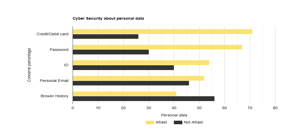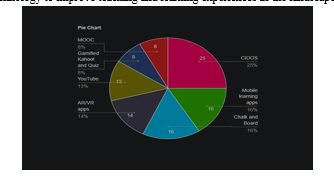Ijraset Journal For Research in Applied Science and Engineering Technology
- Home / Ijraset
- On This Page
- Abstract
- Introduction
- Conclusion
- References
- Copyright
E-Learning using Web 4.0
Authors: Tejas S. Yadav, Mohd Zaid Khan, Mohammed Kaif Tungekar
DOI Link: https://doi.org/10.22214/ijraset.2024.63733
Certificate: View Certificate
Abstract
This paper investigates the integration of Web 4.0 technologies into e-learning platforms, aiming to enhance the efficiency and effectiveness of online education. With the advent of Web 4.0, characterized by advanced semantic capabilities, ubiquitous connectivity, and intelligent data processing, e-learning experiences have the potential to become more personalized, interactive, and engaging. This research paper explores the theoretical foundations, technological components, implementation challenges, and potential benefits of leveraging Web 4.0 in e- learning environments. Additionally, it discusses various case studies and examples to illustrate the practical applications and future directions of this innovative approach to online education.
Introduction
I. INTRODUCTION
The thorough study "E-Learning Using Web 4.0" explores the relationship between Web 4.0 and advanced web technologies in the context of online education.With the introduction of Web 4.0, which is distinguished by its focus on sophisticated data analytics and semantic web technologies, e-learning has attained previously unheard-of levels of effectiveness, personalization, and engagement. Web 4.0 aims to transform education by utilizing technologies like Internet of Things (IoT), machine learning (ML), and artificial intelligence (AI). Learner behavior and preferences are analyzed by AI algorithms, which facilitate the development of customized learning pathways and content recommendations based on individual requirements.
Moreover, real-time data collection and feedback are made possible by the integration of IoT devices with e-learning platforms, creating adaptive learning environments that can change in response to the performance and progress of the learner. In the Web 4.0 era, this dynamic interaction between learners, material, and technology serves as the basis for e-learning.
ELearning has changed dramatically over time, progressing from simple computer-based instruction in the 1960s to sophisticated, interactive, and customized systems in the present day. With the growing use of the internet in the 1990s, web-based training and online learning management systems were introduced, making it a significant decade. Multimedia integration was used in later decades, increasing efficacy and participation. With the introduction of mobile devices in the 2010s, education became even more accessible and anytime, anywhere. AI, VR/AR, and adaptive learning advancements in recent years have changed eLearning by providing customized experiences that meet the needs and interests of each individual. With AI and VR/AR set to completely change the educational environment and provide even more interactive, engaging, and accessible learning opportunities for students everywhere, eLearning is expected to continue innovating in the future.
This paper will examine the significant features and advantages of Web 4.0 technologies in E-Learning, emphasizing how these tools have the potential to revolutionize the field of education and enable students everywhere.
II. THEORETICAL FOUNDATIONS
A. Constructivist Learning Theory
Constructivism has proven to be a very effective approach for illuminating both how children learn and how information is produced in the real world. Additionally, constructivist teaching methods are showing a great deal of effectiveness in advancing student learning and are becoming increasingly common in teacher preparation programs[2].
Web 4.0 enhances constructivist eLearning by offering dynamic, personalized, and interactive experiences. AI algorithms analyze learner data to provide tailored content and activities, promoting self-directed learning. Collaborative tools, such as virtual classrooms and social media platforms, enable learners to engage with peers and experts, fostering knowledge sharing and co-construction.
Furthermore, Web 4.0's integration of IoT devices allows for real-world, hands-on learning experiences. For example, learners can use sensors and actuators to collect and analyze data, applying theoretical concepts in practical contexts.
B. Connectivism
Learning to learn what is necessary today for tomorrow is clearly the true issue for any learning theory, especially when we take into account what the curriculum theory proposes and postulates that the method of learning process is more significant than the assimilation of content. A prerequisite for any learning theory, including new ones like connectivism, is the ability to know and apply what is learnt in the real world with a positive attitude[1].
C. Role of Personalized Learning
For centuries, mentorship and apprenticeship have served as forms of personalized learning. Personalized learning emerged in the form of intelligent tutoring systems throughout the latter half of the previous century as educational technologies started to advance[3].
III. TECHNOLOGICAL COMPONENTS OF WEB 4.0 IN E-LEARNING
A. Semantic Web Technologies
By combining data and web material into a more structured online environment, the Semantic Web has transformed the current document-based web into more intelligent systems that allow software agents to complete tasks for users on their own[5]. An ontology is used by the semantic web to represent the data in a structure that is machine-processable[4].
In Web 4.0, the Semantic Web's principles are further integrated and expanded upon. AI and machine learning technologies are leveraged to analyze and interpret this structured data, enabling a deeper level of understanding and context awareness
B. Internet of Things (IoT)
The term "Internet of Things" (IoT) describes a network of networked items, services, and gadgets that share data via the Internet. This technology is used in a variety of fields and sectors, allowing for easy data sharing[6].In eLearning using Web 4.0, the Internet of Things (IoT) plays a transformative role in enhancing the learning experience. IoT devices, such as sensors, actuators, and smart devices, are integrated into the eLearning environment to collect data, provide real-time feedback, and create interactive learning experiences. One of the key benefits of IoT in eLearning is the ability to create immersive and personalized learning experiences. For example, IoT sensors can track learner behavior and engagement, allowing for adaptive learning pathways and personalized content recommendations. This can help learners stay engaged and motivated throughout their learning journey.
C. Artificial Intelligence and Machine Learning
Artificial Intelligence furnishes relevant data to facilitate decision-making and notify individuals of potential issues[7].
Personalized learning is one important eLearning application of AI. AI is able to suggest particular courses, modules, or resources that are suited to each student's needs by evaluating student data, including learning styles, preferences, and performance. Higher motivation and engagement levels result from this individualized strategy, which improves learning results.
IV. IMPLEMENTATION CHALLENGES
A. Data Privacy and Secuity Concerns
Web 4.0 in education requires complex data privacy and security measures, including secure transmission and storage techniques, effective identity and access management systems, and addressing cyber threats. Balancing accessibility and security requires explicit data governance structures and accountability procedures. A comprehensive strategy involving technology, policy, and user education is necessary for a secure online learning environment.

B. Platform Security Issues
Zoom is a tool that allows students and teachers to connect remotely. It has several benefits, including simple installation, a user-friendly interface, and free usage. However, it faces a number of security concerns, including zoom bombing, end-to-end encryption, Mac espionage, Windows remote code execution, and Cisco Talos vulnerabilities. In 2021, three bug attack chains were revealed that leverage remote code execution (RCE) on the victim's system. Another study discovered more than 10 types of security and privacy vulnerabilities in Zoom. As a result, multiple security weaknesses in Zoom were identified, two of which can allow hackers to see and steal users' data[8].
C. Integration of Diverse Technological Components
The creation of a successful platform necessitates more than just combining teaching content and online capabilities; it must also include a variety of technological components with four primary aspects: sharing, searching, networking, and organizing to meet demand, flexibility, timely delivery, and an efficient learning environment[9].Implementing Web 4.0 in education requires integrating multiple technology components, including learning management systems, virtual classrooms, interactive multimedia, and data analytics solutions. Ensuring interoperability, compatibility, and data privacy is challenging. Careful planning, standardization initiatives, and powerful integration frameworks are needed for successful e-learning.
D. Training and Upskilling Educators
Training and upskilling educators provide substantial implementation obstacles for improving education through Web 4.0, notably in the field of e-learning. Educators must be skilled not just in conventional teaching techniques, but also in using digital tools, online platforms, and data-driven approaches to enable effective online learning. This necessitates extensive training programs that cover a wide range of topics, including instructional design for online settings, the use of e-learning platforms and technologies, data analysis for individualized learning, and approaches for engaging distant learners. Furthermore, educators must keep up with evolving technology and pedagogical practices related to Web 4.0, demanding ongoing professional development programs.Overcoming these problems will need committed resources, coordination between educational institutions and technology suppliers, and a supportive corporate culture that values instructors' lifelong learning.
V. BENEFITS OF WEB 4.0 IN E-LEARNING
A. Enhanced Personalization
Web 4.0 personalizes online learning by integrating AI, ML, big data analysis, and adaptive learning systems. This allows platforms to analyze student behavior and performance data for personalized content and learning pathways[10].In addition, the use of big data analytics enables online learning environments to generate actionable insights from large data sets, including student interactions, assessment results and course content[11]. This knowledge can guide instructional design decisions, allowing teachers to create personalized learning experiences that respond. special needs and preferences of students. In addition, the proliferation of Learning Experience Platforms (LXPs) in the Web 4.0 era has further enhanced the personalization of online learning.
B. Real-time Feedback and Assessment
AI-powered chatbots can provide instant feedback on quiz answers or explain course material, improving student engagement and understanding [12]. Real-time assessment tools can also track student interactions with learning content in real time, allowing teachers to adjust their teaching strategies based on student needs and behavior. In addition, the integration of sensor technologies such as eye tracking and facial recognition can provide additional information about student engagement and attention levels during e-learning activities [13]. By leveraging these technologies, online learning environments can provide more personalized and effective learning experiences that align with Web 4.0 principles.
C. Collaborative and Interactive Learning
Applying technology to create an interactive discussion platform makes collaboration between institutions and sectors easier and more effective.
This interactive and collaborative online platform provides a flexible discussion forum where students from various departments or even students in the city can meet at the most convenient time without the hassle of planning and coordinating meeting arrangements[14].
??????? VI. CASE STUDIES AND EXAMPLES
A. The Need for Digital Learning in Future Education 4.0
The use of digital learning by Malaysian education polytechnics is the particular subject of this case study. Institutions are progressively incorporating technology to improve teaching and learning experiences as the landscape of educationchanges.

B. Important Takeaways
- Student Awareness and Experience:
a. Platform and Tools: Students' awareness and past experiences have an impact on the digital learning platforms and tools they select.
b. User-Centered Approach: When creating e-learning environments, educational institutions take into account students' technological proficiency.
c. Customisation: Adapting online courses to students' interests and level of technology skills.
2. Opportunities and Difficulties:
Ensuring fair access to gadgets and dependable internet connectivity is known as "access to technology."
Digital literacy is the development of digital literacy abilities in instructors and students.
Pedagogical Shift: Changing from traditional classroom instruction to entirely online and blended learning.
Using gamification, interactive material, and teamwork tools are examples of engagement strategies.
Formative and summative evaluations using technology: assessment and feedback.
As an example, the following are some real-world instances of the desire for digital learning:
a. Blended Learning Environments:
Scenario: A web development course is offered by a polytechnic.
Implementation: Online modules are combined with in-person instruction in this course.
Benefits: During in-person instruction, students participate in interactive coding labs and have online access to additional resources.
b. Virtual Labs and Simulations
Suppose that you are taking a chemistry course that calls for hands-on experiments.
Implementation: Students can adjust variables and simulate chemical reactions in virtual labs.
Benefits: Students have real-world experience without having to visit the lab.
c. Collaborative Learning Environments
Situation: Case studies are discussed in a business management course.
Implementation: Peer contact is facilitated by online discussion forums.
Benefits: Students learn from a variety of viewpoints, discuss solutions, and exchange views.
d. Customised Learning Paths
Suppose that students from different backgrounds are admitted to an engineering programme.
Implementation: Content is customised using adaptive learning platforms according to each learner's progress.
Advantages: Students advance at their own speed and receive focused assistance.
Conclusion
Web 4.0 technologies-based e-learning, which provides dynamic, personalised, and interactive learning experiences, is a major improvement in the field of education. The way learning is imparted and experienced has been completely transformed by the integration of AI, IoT, and other cutting-edge technology. In order to meet the needs and preferences of each unique learner, Web 4.0 offers adaptive learning pathways, personalised content recommendations, and real-time feedback. A feeling of community is fostered and learning outcomes are improved when learners and instructors can engage and share knowledge using collaborative tools and virtual environments. Moreover, Web 4.0\'s focus on data analytics makes it possible to continuously enhance eLearning initiatives, guaranteeing their applicability and efficacy. All things considered, eLearning with Web 4.0 has enormous potential to change education and make it more approachable, interesting, and successful for students everywhere.
References
[1] Dorin Herlo, “CONNECTIVISM, A NEW LEARNING THEORY? ”, The European Proceedings of Social & Behavioural Sciences, 21 November 2018. [2] Dr. Rajendra Kumar Shah, “Effective Constructivist Teaching Learning in the Classroom.” Shanlax International Journal of Education, vol. 7, no. 4, 2019, pp. 1–13. [3] Atikah Shemshack & Jonathan Michael Spector, “A systematic literature review of personalized learning terms”, Smart Learn. Environ. 7, 33 (2020) [4] Ahmed, Z.; Gerhard, D. Role of ontology in semantic web development. arXiv 2010, arXiv:1008.1723.5 [5] Muhammad Yahya, John G Breslin, Muhammad Intizar Ali, “Semantic Web and Knowledge Graphs for Industry 4.0”,Appl. Sci., 2021. [6] Nurbek Nasrullayev; Sunbula Muminova; Dilshod Kulmuradov Istamovich; Mokhichekhra Boltaeva, “Providing IoT Security in Industry 4.0 using Web Application Firewall”, 2023,4th International Conference on Electronics and Sustainable Communication Systems (ICESC) [7] Mohd Javaid, Abid Haleem, Ravi Pratap Singh, and Rajiv Suman , “Artificial Intelligence Applications for Industry 4.0: A Literature-Based Study”, Journal of Industrial Integration and ManagementVol. 07, No. 01, pp. 83-111 (2022). [8] Lourdes Cecilia Ruiz Salvador,Carlos Lenin Alvarez Llerena,Dr. Huu Phuoc Dai Nguyen ,“DIGITAL EDUCATION: SECURITY CHALLENGES AND BEST PRACTICES”,Security Science Journal,2021. [9] Lilian Lee Shiau Gee, “Integrating Design Features for E-Learning Platforms”,International Academic Symposium of Social Science 2022. [10] Sun, Y., Sang, Y., Zhu, Y., & Xie, B. ,’ Big data analytics in e-learning: A systematic review’. Computers & Education, 133, 137-156,2019. [11] Dhawale, R., & Karpe, A., ‘Big data analytics in e-learning: A review’. In Data Science in Education Using Python (pp. 3-23). Springer, Cham,2020 [12] Winkler, R., Ritter, C., Geller, S., & Pinkwart, N. ‘Chatbots for Education: A Systematic Review’. Journal of Educational Technology & Society, 24(1), 143-159,2021. [13] Khan, M. A., Wongseree, W., & Janwittayaprasert, C. , ‘Leveraging sensor technologies in online education: A review of opportunities and challenges’, Computers & Education, 158, 103962,2020. [14] Abdul Bujang, Siti Dianah & Selamat, Ali & Krejcar, Ondrej & Maresova, Petra & Nguyen, Ngoc Thanh. (2020). Digital Learning Demand for Future Education 4.0—Case Studies at Malaysia Education Institutions. Informatics. 7. 13. 10.3390/informatics7020013.
Copyright
Copyright © 2024 Tejas S. Yadav, Mohd Zaid Khan, Mohammed Kaif Tungekar. This is an open access article distributed under the Creative Commons Attribution License, which permits unrestricted use, distribution, and reproduction in any medium, provided the original work is properly cited.

Download Paper
Paper Id : IJRASET63733
Publish Date : 2024-07-23
ISSN : 2321-9653
Publisher Name : IJRASET
DOI Link : Click Here
 Submit Paper Online
Submit Paper Online

